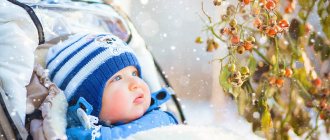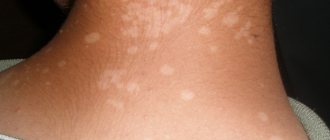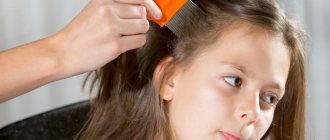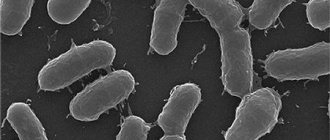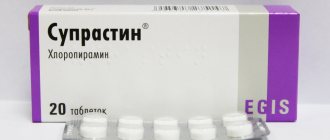Peeling of the scalp in infants at 2-3 months
If the crusts on the head have no odor, there is no inflammation, this is considered normal.
Parents should not panic and sound the alarm if they see that the baby’s head is peeling - this is a natural phenomenon. An exception may be the case when dryness is accompanied by other alarming symptoms.
The child developed for nine months surrounded by liquid, and after birth found himself in an air space. His skin begins to gradually adapt to the new environment. Dryness is a peculiar reaction.
Also, crusts appear against the background of active work of the sebaceous gland. Infants have much more sebaceous secretions, as they have a protective function. Block the penetration of infections, harmful bacteria and various viruses. By the age of one year, the performance of the gland is normalized and the unpleasant symptoms disappear without a trace or consequences.
Milk (seborrheic) crusts: what to do?
Most often, milk crusts occur from the first to the third months of a child’s life.
and in some cases last up to 6–9 months.
Causes
- Imbalance in the functioning of the sweat and sebaceous glands.
- Washing your hair too infrequently (less than once a week).
- Using unsuitable cleaning agents. Adult shampoos or soaps irritate a baby’s sensitive scalp and disrupt the sebaceous glands, and strong fragrances can cause allergies.
- Seborrheic crusts often appear in babies, whose parents put on caps or caps even in hot weather. Overheating provokes sweating, which the baby’s excretory system cannot yet cope with.
Why can’t milky crusts be combed out?
The milk crusts themselves are harmless. They cause discomfort to the baby only when parents begin to actively remove them! Why is that?
- If you remove the crusts carelessly, you can injure the baby’s skin and cause him pain.
- A secondary infection may enter the wound.
- When combing there is a risk of damaging hair follicles
How to get rid of milk crusts and prevent their reappearance?
To get rid of milk crusts at home, use special products designed for newborns. Preferably without fragrances, parabens and harsh surfactants. The priority is natural ingredients, gentle exfoliating components and a hypoallergenic formula.
What is unique about the Mustela milk crust line?
The patented active components included in the products help to avoid the spread of the process and maintain the health of the hair and scalp without resorting to combing.
— It acts not only on the symptom, but also on the cause of the formation of the inflammatory environment¹.
— Results on average in 7 days².
— Effective for both eliminating and preventing the appearance of crusts³.
Which product is right for your baby and how not to make a mistake with the choice? Let's find out!
You need Milk Crust Cream if...
- Crusts are dense, yellowish
- Cover a significant area of the scalp
- Apply to the skin of the face and neck
Mustela Milk Crust Cream contains 95% ingredients of natural origin.
It
promotes rapid removal of crusts, on average in 7 days²
and
in 100% of cases has a keratolytic effect, without combing² .
You need a foam shampoo if...
- The crusts are light, thin
- Located only on the head
- You want to prevent their appearance without waiting for milk crusts to appear
Mustela Foam Shampoo contains 99% ingredients of natural origin.
It
helps soften and wash away milky crusts³. In 100% of cases,
the product
helps prevent the reappearance of crusts³.
Comprehensive care regimen from Mustela for milky crusts:
Frequency of use when eliminating “complex” crusts with a large area of distribution: 1 time per day. 1.
Apply Cream for “milk crusts” to problem areas and leave for 6-8 hours (use it until the crusts completely disappear)
2.
Wash off the Cream using Foam Shampoo, carefully massaging the scalp
3.
To prevent the reappearance of crusts, use Shampoo- Mustela foam on a regular basis
____________________________________
1. Avocado Polyphenols activity in the hair axis (September 2019) / Action of avocado polyphenols on hair (September 2019); 2. A clinical study to evaluate the effectiveness of Cream for milk crusts, was carried out under the supervision of dermatologists and pediatricians, with the participation of 60 children aged from 2 days to 35 months 3. A clinical study to evaluate the effectiveness of Foam Shampoo, was carried out under the supervision of dermatologists and pediatricians, with involving 38 children aged from 10 days to 3 years
How to identify the pathogen
It is almost impossible not to notice peeling, but there are still certain criteria that help to accurately identify the problem. Symptoms that are considered normal:
- the presence of a white or yellow crust;
- absence of any odor;
- problem areas make you want to scratch;
- the flaked pieces of skin resemble dandruff.
If you have any disease, slight swelling and redness may appear. In some cases, ignoring the symptoms can lead to the crust moving from the head to other parts of the body. Situations like this require medical attention.
Features of the influence of external and internal factors
After bathing, the crusts are gradually combed out.
Various factors can provoke the appearance of dry crusts. It is worth considering each case separately. External reasons include:
- Detergents. Soap and other care products contain a high content of chemicals and alkali. These components negatively affect the skin and cause excessive dryness. You should not resort to washing with soap and shampoo every day.
- Increased sweating occurs due to excessive wrapping. The child sweats, the hair becomes damp, irritation and flaking appear.
- Sun rays in large quantities negatively affect the baby’s skin, causing burns, which are accompanied by peeling. At sea, during walks, you should avoid direct contact with the sun.
- Synthetic bedding is the main irritant to a child's delicate skin. Only products made from natural, undyed fabric are suitable for babies.
- Powders and conditioners used when washing children's clothes can remain in the fabric, they provoke the appearance of peeling. It is worth giving preference to high-quality detergents that are designed specifically for children.
To make the scales separate faster, use an oil gel or cream.
Dryness is often caused by other irritants, which are more difficult to identify. A newborn’s head peels for the following reasons:
- Allergy. The mother needs to carefully monitor her diet, as she has a physiological connection with the baby. While breastfeeding, do not consume potential allergens: citrus fruits, chocolate, bee honey and seafood, otherwise all this will immediately affect the baby’s skin.
- Individual intolerance to formula milk if the child is artificially fed. It’s worth trying a different brand, since the problem cannot be solved without removing the main irritant.
- Fungal diseases are very often accompanied by peeling, but the disease is rarely found in newborns; children from two years of age are more likely to experience it. The exception is congenital ichthyosis. Both problems require drug treatment.
- Intestinal problems and helminthiasis. With these pathologies, additional symptoms appear: redness, itching and rash.
Vitamin deficiency is also an internal cause of skin problems. This situation requires contacting a pediatrician. Giving vitamin complexes to a child on your own is strictly prohibited.
How to choose a shampoo and will it help?
The easiest way to get rid of crusts is to apply baby shampoo to your baby's scalp and leave it on for 5-10 minutes while bathing. The crusts will become softer. Some of them will be washed off during rinsing, some will come off when you dry the child’s head with a towel, the rest will need to be carefully combed out with a soft brush or a comb with rounded teeth at the ends. If there are few crusts, then one or two such procedures will be enough. If there is a lot, then more.
To combat crusts, any baby shampoo approved for use from the first days of a child’s life is suitable. But if you wish, you can purchase a special shampoo for milk crusts. Will it be more effective than regular? Read the reviews. For some it helps immediately, for others it doesn’t help at all. If the baby has a lot of crusts and layers, then most likely the shampoo will not give a quick effect. Other remedies for crusts To combat profuse manifestations of seborrheic dermatitis, oil products are suitable: children's cosmetic oil, special oil gel against crusts, emollient cream. Half an hour to an hour before bathing, smear the child’s head with this product and put a hat on him. While bathing, wash your baby's hair with baby shampoo, and then comb it with a soft brush or blunt-tooth comb.
It is important!
One procedure may not be enough. After a few days, if necessary, it can be repeated. Do not overdo it. Using shampoo every day will dry out your baby's scalp and make his sebaceous glands work even harder. That is, the effect will be the opposite: there will only be more crusts.
If you notice that under the scabs your baby’s skin is red, begins to get wet, and bleeds, consult a doctor. It is also worth showing your baby to the doctor if crusts cover not only his head, but also his face, neck, and groin.
So:
- Crusts on the baby’s head are formed due to the intense secretion of sebum under the influence of maternal hormones, as well as due to the activity of Malassezia fungi, which are present on the skin of every person.
- It is not necessary to remove milk crusts, but they will take a long time to disappear.
- You can choose any shampoo to combat milk crusts, the main thing is that it is approved for use from the first days of life. The use of a special shampoo against milk crusts does not guarantee a complete and quick effect.
- You can remove milk crusts using baby oil. To do this, you need to apply it under your cap an hour before bathing, and then rinse with shampoo and carefully comb out the crusts with a soft brush.
- If these remedies do not help, and crusts appear not only on the head, but also on the child’s face and body, consult a doctor.
(1 ratings; article rating 5.0)
Share Share Share
Is it necessary to remove crusts from a baby's head?
If an infection gets into the skin, it is necessary to use antifungal ointments.
The crusts, as a rule, go away on their own by one year, so there is no need to do anything to eliminate them. According to pediatrician Komarovsky, measures should be taken in the following cases:
- suppuration forms;
- an unpleasant odor appears;
- a weeping surface is formed with the release of ichor;
- there is redness and swelling around the crust.
These symptoms indicate that an infection has penetrated the skin. These cases require contacting a clinic.
Treatment for peeling skin
Seborrheic dermatitis requires longer treatment.
Peeling needs to be treated if it is caused by any disease. All other cases do not need this; it is enough to carry out the treatment twice a day. You can use the old proven method:
- boil vegetable oil;
- cool it down;
- wipe problem areas on the head with a cotton pad soaked in oil.
The pharmacy has a wide selection of cosmetic mixtures for treating peeling skin. You can choose the oil taking into account your skin characteristics and individual intolerances.
Prevention of flaking of the scalp in infants
Preventive measures include strict adherence to the rules of hygiene and care.
- Do not use regular soap or gel for adults when bathing a newborn. It is better to use baby soap; it does not contain irritants or other substances dangerous to the baby.
- Water is pre-cleaned from chlorine, this is done by boiling, filtering or settling for several days. It is recommended to add herbal infusions as an emollient.
- After bathing, the head and body are dried with a soft towel, and the skin is treated with baby powder or special oil. If there is peeling on the baby's head, the crusts are combed out; for this you will need a soft brush without sharp metal teeth.
It is important to maintain a microclimate in the children's room that is comfortable for a newborn to live in. The temperature should be between 20-22 degrees, optimal humidity from 50 to 70%.
Causes of peeling skin in children
Children quickly react to factors in the space around them. In addition to dry air and the adaptation period after birth, there are a number of other reasons for the appearance of peeling:
- improper care and hygiene violations;
- reaction to dry air or cold;
- allergic reaction to hygiene products, food;
- clothing made of synthetic materials;
- congenital diseases;
- lack of vitamins A and E.
Each of these reasons is widespread, but they are not always immediately excluded as a provoking factor. Dry air can be humidified. The optimal indicator for an infant is 50-60%. If necessary, it is recommended to change shampoos, soaps and bathing gels to hypoallergenic ones. Children 1 year of age and older may have a helminthic infestation. This provokes intoxication of the body, and hence skin manifestations. With treatment and regular care, peeling goes away.

